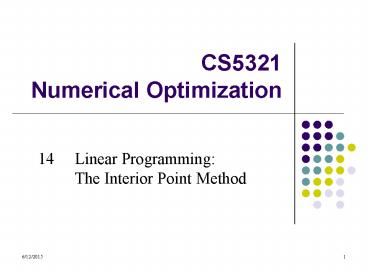CS5321 Numerical Optimization - PowerPoint PPT Presentation
1 / 12
Title:
CS5321 Numerical Optimization
Description:
CS5321 Numerical Optimization 14 Linear Programming: The Interior Point Method Interior point methods for LP There are many variations of IPM for LP Primal IPM, dual ... – PowerPoint PPT presentation
Number of Views:88
Avg rating:3.0/5.0
Title: CS5321 Numerical Optimization
1
CS5321 Numerical Optimization
- 14 Linear Programming The Interior Point
Method
2
Interior point methods for LP
- There are many variations of IPM for LP
- Primal IPM, dual IPM, primal-dual IPM
- Potential Reduction Methods
- Path Following Methods
- Short-step methods
- Long-step methods
- Predictor-corrector methods
- We will cover the path following method and the
long-step method
3
The dual problem of LP
- minxzcTx subject to Ax b, x ? 0
- The dual problem is (see chap 12)
- max?bT? subject to AT ? s c, s ? 0
- Weak duality
- For any x and ? that are feasible in the primal
and the dual problems, bT? ? cTx. - Strong duality
- If x and ? are solutions to the primal and
the dual problems, bT? cTx.
4
Optimality conditions of LP
- minxzcTx subject to Ax b, x ? 0
- The Lagrangian function
- L(x,?,s) cTx - ?T(Ax-b) - sTx
- The optimality conditions (KKT, see chap 12)
- The last one is the complementarity condition
5
Primal-dual method
- The optimality conditions can be expressed as
- Xdiag(x), Sdiag(s) and e(1,1,,1)T.
- F is a nonlinear equation R2nm ? R2nm.
- Solved by the Newtons method (J the Jacobian
of F.) - (x, ?, s)?(?x, ??, ?s),
6
Jacobian of F
- Let .
- The Jacobian J (x, ?, s) of F(x, ?, s) is
7
Solving the linear systems
- The Newtons direction is obtained by solving
- S is an artificial variable. Let
- The left hand side is symmetric, but indefinite.
8
Centering
- In practice, rXSXSe -??e rather than rXSXSe.
- Duality measure
- Centering parameter ? ? 0,1
- Decreasing as approaching solutions
- This is related to the barrier method (chap 15)
9
The path following algorithm
- Given (x0,?0,s0) with (x0,s0)gt0
- For k 0, 1, 2 until (xk)Tsklt ?
- Choose ?k?0,1 and let ?k(xk)Tsk/n.
- Solve the Newtons direction (?xk, ??k, ?sk)
- Set (xk1, ?k1, sk1)(xk, ?k, sk) ?k(?xk,
??k, ?sk), where ?k is chosen to make
(xk1,sk1)gt0
10
Central path and neighborhood
- Feasible set F0(x,?,s) Axb, AT?sc,
(x,s)gt0 - Point (x?,??,s?)?F0 is on the central path C if
x?(i)s?(i) ? for all i1,2,,n. - An example of the neighborhood of the central
path - ? is the duality measure (two slides before)
- Typically ?10-3.
11
Long-step path-following
- Given (x0,?0,s0)?N-? and ?, ?min, ?max.
- For k 0, 1, 2 until (xk)Tsklt ?
- Choose ?k??min,?max and let ?k(xk)Tsk/n.
- Solve the Newtons direction (?xk, ??k, ?sk)
- Set (xk1, ?k1, sk1)(xk, ?k, sk) ?k(?xk,
??k, ?sk), where ?k is chosen to make (xk1,
?k1, sk1)?N-?.
12
Complexity
- The long step following method can converge in
O(nlog(1/?)) iterations (Theorem 14.4) - The most effective interior point method for LP
is the predictor-corrector algorithm (Mehrotra
1992)































